Credit Crisis Worse to Come as Bank Credit Contracts
Stock-Markets / Credit Crisis 2008 Nov 11, 2008 - 07:10 AM GMTBy: John_Mauldin

 Can the credit crisis get any worse? In this week's Outside the Box my London partner Niels Jensen shows that it indeed can. Banks, and mainly European banks, have large exposure to emerging market debt of all types through both sovereign, corporate and individual loans. Just as banks have had to write down large losses from the subprime crisis and other related problems, next will come a wave of potential losses from yet another source. Niels then goes on to give us a look the size and problems with hedge fund deleveraging. Altogether, this is a very interesting letter and one that is written from a non-US point of view that I think you will find instructive.
Can the credit crisis get any worse? In this week's Outside the Box my London partner Niels Jensen shows that it indeed can. Banks, and mainly European banks, have large exposure to emerging market debt of all types through both sovereign, corporate and individual loans. Just as banks have had to write down large losses from the subprime crisis and other related problems, next will come a wave of potential losses from yet another source. Niels then goes on to give us a look the size and problems with hedge fund deleveraging. Altogether, this is a very interesting letter and one that is written from a non-US point of view that I think you will find instructive.
Niels Jensen is Managing Partner of Absolute Return Partners based in London, which is a boutique alternative investment firm ( www.arpllp.com ). You can write Niels at info@arpllp.com if you like with your comments and questions.
John Mauldin, Editor
Outside the Box
When the Chickens Come Home to Roost
by Niels Jensen
The helicopters are here
You may remember my prediction last month that Bernanke's helicopters were on their way. I cannot resist the temptation to show you this chart, courtesy of John Williams at Shadow Government Statistics (see chart 1). The US monetary base has literally exploded in recent weeks and is up a staggering 38% year-on-year - the highest increase since 1939 according to my good friend Simon Hunt at Simon Hunt Strategic Services. Not entirely surprising, you might say. After all, you would expect the Federal Reserve Bank to react swiftly in response to the drama unfolding in front of our eyes.
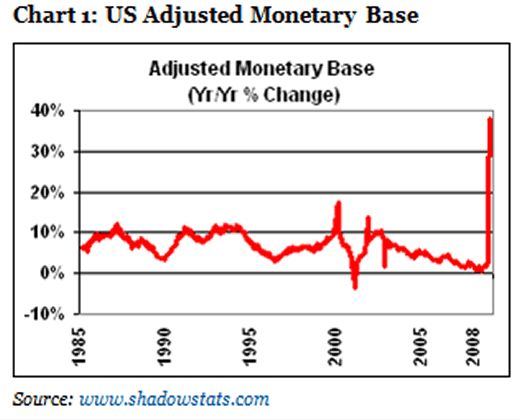
I just wish we had central bankers here in Europe who would be prepared to move as quickly and as decisively as their colleagues on the other side of the pond. Our 'eurocrats' continue to worry unnecessarily about inflation and, by not acting aggressively enough, it is more than likely that the recession which is engulfing us as we speak will end up doing considerably more damage here in Europe than in the US.
Bank lending is responding
Meanwhile, in the US, bank lending is already responding to Fed's tactics. Total commercial and consumer bank lending has grown by an annualised rate of almost 50% in the last month and a half. Quite impressive in an economy which is supposedly in recession.
So far so good. The problem is, however, that the near meltdown has unleashed an asteroid storm of problems. Take Iceland. As most investors know by now, Iceland is in very serious trouble. According to at least one estimate, European banks stand to lose about $75 billion on Iceland - not exactly pocket change. And that is on a population the size of Coventry! Earlier this week, the Central Bank of Iceland raised the policy rate from 12% to 18%. Inflation is now running at about 16% and will undoubtedly peak at much higher levels. According to Danske Bank, expect it to hit 75% before things get better. That is ugly.
The canary in the coalmine
I have an increasingly uneasy feeling that Iceland is the canary in the coalmine. Hungary is struggling. So are Pakistan, Ukraine, Belarus, Romania and Argentina. Cristina Fernández de Kirchner, the President of Argentina, took everyone by surprise last week when she announced that the country's private pension funds (about $26 billion) would be transferred into the state pension system. The official line is that she is aiming to protect the country's pension funds from the global turmoil. Who is she kidding?
Now, the Federal Reserve Bank has decided to provide emergency loans to Mexico, Brazil, Singapore and South Korea. Not that long ago, it was Singapore (amongst others) which provided emergency funding to the ailing US banking sector. If countries such as South Korea and Singapore require help from the outside, the state of affairs in other and less developed nations could be much worse than generally perceived.
Looking at the evidence produced in a new Goldman Sachs research paper 1 , it is primarily Eastern Europe one has to worry about. Credit growth in Eastern Europe and Latin America has been much stronger than in emerging Asia (chart 2).
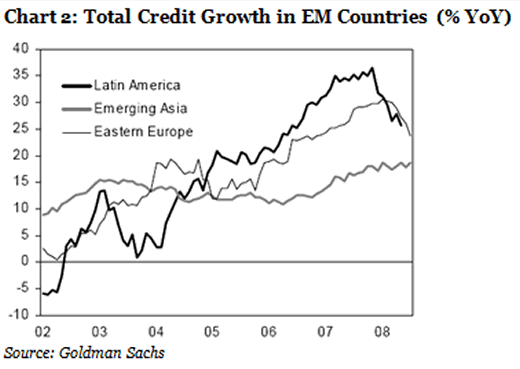
However, if you then look at the state of the current account (chart 3), it is evident that Eastern Europe is facing a much bigger challenge than the other two regions. Their current account deficit has grown dramatically since the turn of the Millennium and now stands at close to 10% of GDP.
This puts Eastern Europe in a very vulnerable situation. When Asia was in a similar situation back in the late 1990s, it ended in tears with currencies blowing up and consumer spending collapsing. Ultimately, though, it resulted in much improved current accounts as the weak currencies led to an export boom, but there was considerable pain before they got to that point.
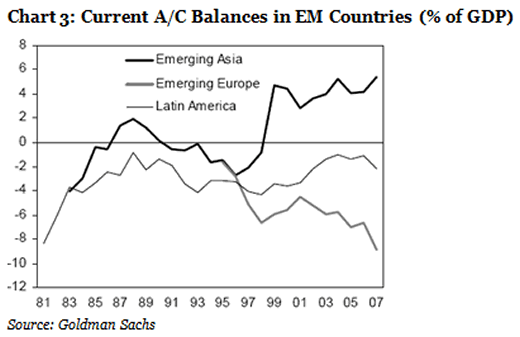
Stephen Jen and Spyros Andreopoulos at Morgan Stanley have further explored the subject 2 . They suggest that an already weak banking sector in the OECD could be further stifled by non-performing loans to emerging market countries.
European banks at risk
Worldwide cross-border lending now stands at $37 trillion with about $4.7 trillion going towards Eastern Europe, Latin America and emerging Asia. Cross-border lending by European and UK banks to emerging market countries accounts for 21% and 24% of respective GDPs compared to 4% for US banks and 5% for Japanese banks (see chart 4). Europe has about $3.5 trillion of debt outstanding to emerging market countries whereas the US has only about $500 billion on the line.
The country most exposed to emerging markets is Austria with total emerging market loans accounting for no less than 85% of the country's GDP - most of it to Eastern Europe. Austrian banks have been aggressively pursuing opportunities in Eastern Europe for years. They have in fact been so aggressive that their total lending to the region (approximately $300 billion) exceeds the amount lent by Germany to Eastern Europe. Even more worryingly, Austrian banks are the largest holders of debt on Hungary and Ukraine - two of the most fragile economies on the old Soviet bloc. As an aside, when the global banking system collapsed in May 1931 in the midst of the Great Depression, it was a run on the Austrian banks which acted as a catalyst.
Italy is possibly in an even more dire condition. According to a recent article in The Daily Telegraph 3 , Italy's public debt is now the third largest in the world, behind the US and Japan. And, at 107% of GDP, it is almost twice the limit set by the Maastricht Treaty (so much for treaties!). Italy is also a big lender to Eastern Europe. Unicredit alone has about $130 billion of debt outstanding to Eastern European countries. Italy's predicament is well recognised by fixed income investors. 10-year Italian government bonds now yield 1.08% more than their German sister bonds. The market is telling us that something rather unpleasant could happen to Italy. It is even possible that Italy could be forced to pull out of the euro, unless they can turn the ship around fairly quickly.
Meanwhile, UK banks are primarily exposed to emerging Asia and Latin America. Only Poland stands out in Eastern Europe as a major recipient of loans from UK banks and Poland is perhaps not up to its neck in problems the way Hungary and Ukraine are right now, but the situation is deteriorating there as well. Sweden is mostly exposed to the Baltic countries. The three Baltic countries owe a total of $123 billion, $83 billion of which originate from Sweden. Knowing that Latvian banks in particular have been rather innovative with the structure of their mortgage products (such as Yen based loans), would you sleep well if you were the credit officer of one of the major Swedish banks?
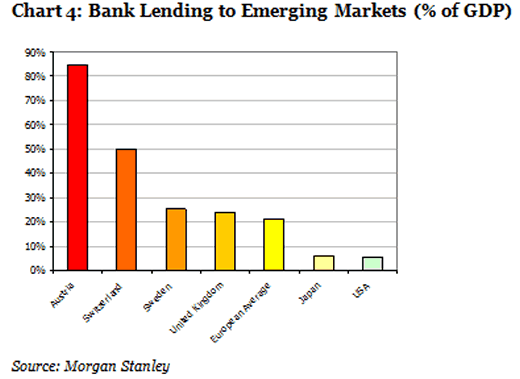
Spain is the Latin juggernaut
Spain is another worry. Contrary to popular belief, the US is not the largest lender to Latin America - Spain is. Just under $1 trillion of cross-border debt is outstanding across Latin America. Only 17% of that comes from US banks. Spanish banks, on the other hand, have more than 30% of the debt on their books. Let's hope for Spain's sake that Ms. Kirchner is telling the truth when she claims that the nationalisation of the private pension funds was done to protect them from the evils of this world. Somehow I doubt it.
The sharp rise in the value of the US dollar and the Yen is not helping emerging market economies either. We do not know exactly what proportion of the $4.7 trillion of loans to emerging market countries are denominated in US dollars and Yen respectively, but we suspect that it is a significant share. As long as the world is deleveraging, you should expect both currencies to continue to appreciate in value, as most carry trades have been based on either US dollars or Yen. Meanwhile, some countries are putting up a brave fight (e.g. Hungary and Romania). However, as we learned in 1992, a wounded currency is like a bleeding torso in shark infested waters. You can rest assured that speculators will finish off the job. No central bank can win that battle.
One might argue that a devaluation of the Hungarian currency or a collapse of the Pakistani economy won't really affect your portfolio, but that misses the point. It is the risk to an already wounded banking industry you have to worry about. And, as I have pointed out above, European banks are much more exposed to emerging market countries than their US competitors.
Annus Horribilis
Enough said about emerging market risk for now. My other big worry at the moment is what is happening to (some) hedge funds. Clearly, 2008 has been to hedge fund investors what 1992 was to Queen Elizabeth II - Annus Horribilis (see chart 5).
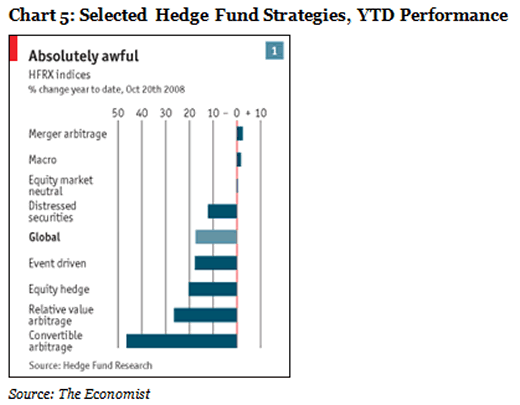
Merrill Lynch did a study recently, showing that the 30 biggest US equity holdings amongst US hedge funds were amongst the poorest performers in the S&P500 4 . In other words, it is likely that much of the recent sell-off in equity markets around the world can be traced back to hedge fund liquidations.
There is no question that hedge funds are downsizing at present. The problem is to obtain precise data on the phenomenon. If we estimate that the global hedge fund industry controls about $2 trillion of capital, and we assume that 15-20% is going to be pulled out between now and year-end (which is not far from the truth according to our sources), $3-400 billion must be returned to investors between now and 31 st December.
Deleveraging continues
That is not the whole story though. The average hedge fund uses leverage, to the tune of about 1.4 times (see chart 6). This is down significantly from a year ago, but it still means that hedge funds need to liquidate investments of at least $500-550 billion in order to meet current redemption requests. And the real number is probably higher because some of the worst performing strategies this year are the ones using the most leverage. The real number is therefore more likely $6-800 billion, and that is a big enough sum of money to put downward pressure on the markets.
Add to this the fact that some hedge funds (mostly the bigger ones) have been selling credit default swaps (CDSs). A CDS is an insurance against corporate default. The buyer of a CDS supposedly makes money if the underlying credit blows up. I say 'supposedly' because the payment is a function of the seller's ability to pay up. That was why Morgan Stanley had to be saved at all cost. MS has been, and continues to be, one of the largest players in the CDS market.
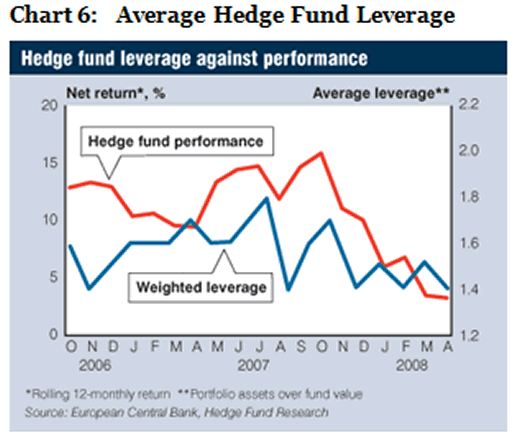
There is no way we can establish precisely how many CDSs hedge funds have on their books, but please consider the following: The CDS market is a $50 trillion market (give or take). Before they blew up, AIG were one of the biggest sellers of CDSs with approximately $500 billion on their books. They ran into problems (partly) because they were heavily exposed to the financial services industry which is already in recession.
Recession in the early stages
The rest of the economy, however, is not yet in recession - or rather, we do not have the statistics to prove it. Corporate defaults are still low, both here and in the US. But corporate defaults will go up as they always do in recessions. If AIG, one of the largest and most sophisticated financial institutions could get themselves into trouble with barely a 1% share of the global CDS market, what will happen to the sellers of the remaining 99%?
Who 'owns' this risk? Is it hedged or not? Is it even possible to hedge the risk, knowing that your counterparty might not be able to pay up? What we do know is that only the larger hedge funds have participated in the practise of selling CDSs. Right now it feels very good not to be invested in those types of hedge funds (as you may be aware, our focus is on alternative investment strategies away from mainstream hedge funds). I also suspect that the extreme volatility in recent weeks is somehow related to this phenomenon. Investor redemptions are not the whole story.
Conclusion
I pointed out several months ago that the world's stock markets would present several 'false dawns' before we could finally declare victory against the bear market. Last week's more upbeat tone was one such 'false dawn', in my opinion. There are three reasons for that:
Firstly, investors have not yet fully capitulated, and that is a necessary condition for markets to turn around. It is best illustrated by a survey conducted by BCA Research at the end of their two-day investment conference held in New York on 20-21 st October. Only five or six of the more than 250 people in the room expected the stock market to be lower a year from now 5 . Not consistent with capitulation! Having said that, it is perfectly normal to experience powerful rallies in the midst of a major bear market. The sharpest rallies in history have actually been bear market rallies.
Secondly, de-leveraging has a long way to run yet, not so much in the hedge fund community where I suspect that much of the damage will be behind us once we pass the next major redemption hurdle on 31 st December, but in society more broadly. Governments, banks, (some but not all) companies and, most importantly, the majority of households are more leveraged than good is. I have borrowed Chart 7 below from BCA Research, and it shows total US bank loans as a percentage of US GDP. Unfortunately, the picture would be much the same for many of the European countries. We are now facing a major de-leveraging cycle and it will suppress economic growth and put a lid on the stock market for years to come.
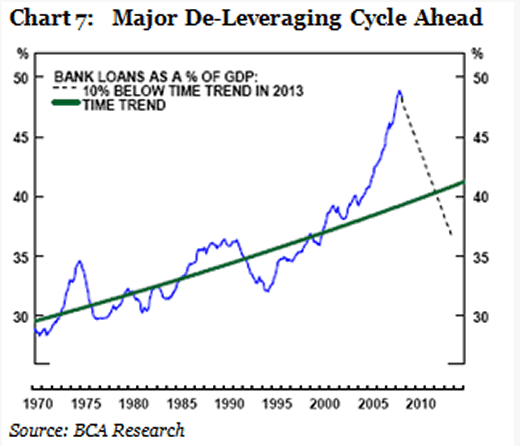
Thirdly, whereas I fully agree that the worst of the financial crisis might now be behind us, bear in mind that we have not yet seen the full effect of the economic crisis. We are only in the first or second innings of this recession, and the emerging market story has the potential to wreak further havoc. So do credit default swaps - or something else. Recessions are by nature quite unpredictable. There is one thing I am sure about, though. Just as for New Year's Eve, the more extravagant the party, the bigger the hangover. Prepare for this one to linger for a while yet.
Niels C. Jensen
© 2002-2008 Absolute Return Partners LLP. All rights reserved.
1 Global Economic Weekly, 29 th October, 2008
2 "Europe more exposed to EM bank debt than the US or Japan", Morgan Stanley, 27 th October, 2008
3 "Traders warn of Italian iceberg", The Daily Telegraph, 31 st October, 2008
4 Source: "Hedge Funds in Trouble", The Economist
5 BCA Research Global Investment Strategy, 24 th October, 2008
By John Mauldin
John Mauldin, Best-Selling author and recognized financial expert, is also editor of the free Thoughts From the Frontline that goes to over 1 million readers each week. For more information on John or his FREE weekly economic letter go to: http://www.frontlinethoughts.com/learnmore
To subscribe to John Mauldin's E-Letter please click here:http://www.frontlinethoughts.com/subscribe.asp
Copyright 2008 John Mauldin. All Rights Reserved
John Mauldin is president of Millennium Wave Advisors, LLC, a registered investment advisor. All material presented herein is believed to be reliable but we cannot attest to its accuracy. Investment recommendations may change and readers are urged to check with their investment counselors before making any investment decisions. Opinions expressed in these reports may change without prior notice. John Mauldin and/or the staff at Millennium Wave Advisors, LLC may or may not have investments in any funds cited above. Mauldin can be reached at 800-829-7273.
Disclaimer PAST RESULTS ARE NOT INDICATIVE OF FUTURE RESULTS. THERE IS RISK OF LOSS AS WELL AS THE OPPORTUNITY FOR GAIN WHEN INVESTING IN MANAGED FUNDS. WHEN CONSIDERING ALTERNATIVE INVESTMENTS, INCLUDING HEDGE FUNDS, YOU SHOULD CONSIDER VARIOUS RISKS INCLUDING THE FACT THAT SOME PRODUCTS: OFTEN ENGAGE IN LEVERAGING AND OTHER SPECULATIVE INVESTMENT PRACTICES THAT MAY INCREASE THE RISK OF INVESTMENT LOSS, CAN BE ILLIQUID, ARE NOT REQUIRED TO PROVIDE PERIODIC PRICING OR VALUATION INFORMATION TO INVESTORS, MAY INVOLVE COMPLEX TAX STRUCTURES AND DELAYS IN DISTRIBUTING IMPORTANT TAX INFORMATION, ARE NOT SUBJECT TO THE SAME REGULATORY REQUIREMENTS AS MUTUAL FUNDS, OFTEN CHARGE HIGH FEES, AND IN MANY CASES THE UNDERLYING INVESTMENTS ARE NOT TRANSPARENT AND ARE KNOWN ONLY TO THE INVESTMENT MANAGER.
John Mauldin Archive |
© 2005-2022 http://www.MarketOracle.co.uk - The Market Oracle is a FREE Daily Financial Markets Analysis & Forecasting online publication.


